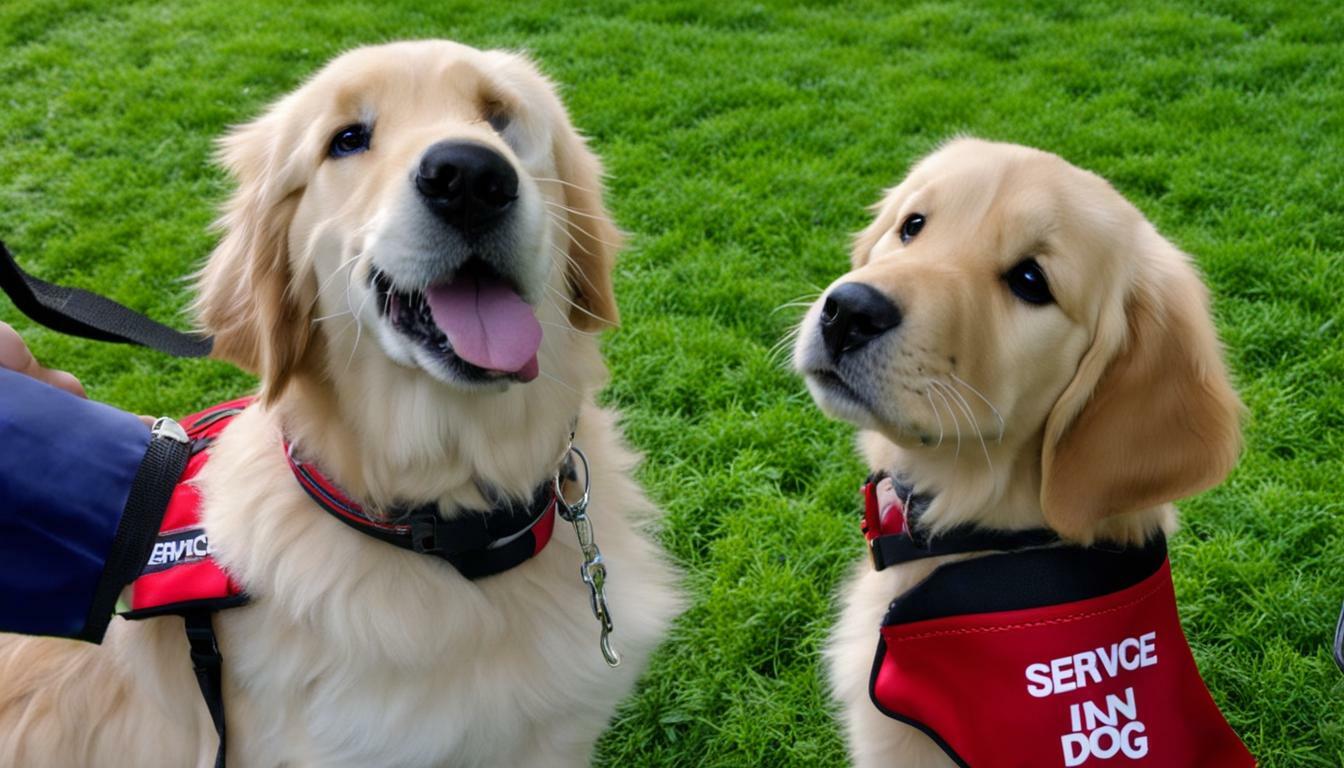Training a dog to stop barking at strangers can be a challenging endeavor for dog owners. It is a behavior that can not only be disruptive but also potentially dangerous if not addressed. Fortunately, with patience, consistency, and the right techniques, it is possible to modify this behavior and teach your dog to greet strangers respectfully.
Key Takeaways:
- Addressing a dog’s barking behavior requires patience and consistency.
- Understanding why dogs bark at strangers is crucial in addressing the underlying causes.
- Training methods such as ignoring and rewarding good behavior, walking away and rewarding calm behavior, distracting with noise and rewarding quietness, and teaching the dog to stay calm and rewarding good behavior can be effective.
- Consistency, positive reinforcement, and patience are essential throughout the training process.
- Addressing specific behavioral challenges and focusing on prevention through socialization are key strategies in training a dog to stop barking at strangers.
Understanding Why Dogs Bark at Strangers
Dogs bark at strangers for various reasons, including territorial instincts and fear-driven behavior. Understanding these underlying causes can help dog owners address this behavior and train their dogs to stop barking excessively.
Territorial instincts: Dogs are naturally protective of their territory, which can include their home, yard, or even their owners. When a stranger enters their territory, they may bark to alert their owners and establish their presence. This behavior is rooted in their instinct to protect their space.
Fear-driven behavior: Dogs may also bark at strangers out of fear. This fear can be triggered by unfamiliar people, unusual behaviors, or previous negative experiences. Barking serves as a defense mechanism, signaling to the stranger that the dog feels threatened or uncomfortable.
Addressing these reasons for barking requires patience and consistency. By employing effective training methods, dog owners can help their dogs overcome fear and territoriality, allowing them to greet strangers respectfully and reduce excessive barking.
| Training Methods | Benefits |
|---|---|
| Ignoring and rewarding good behavior | Teaches the dog that quiet behavior is rewarded |
| Walking away and rewarding calm behavior | Helps the dog associate calmness with positive experiences |
| Distracting with noise and rewarding quietness | Redirects the dog’s attention and reinforces desired behavior |
| Teaching the dog to stay calm and rewarding good behavior | Teaches the dog to remain composed when encountering strangers |
It’s important to remember that training takes time, and consistency is key. By using these techniques and understanding the reasons behind the barking, dog owners can effectively train their dogs to stop barking at strangers and create a more peaceful and well-behaved environment for both the dog and their owners.
Ignoring and Rewarding Good Behavior
One effective method to address excessive barking at strangers is to ignore the behavior and reward the dog for remaining quiet. Dogs often bark to seek attention, so by ignoring their barking, we can teach them that this behavior does not get them the desired response. When the dog eventually stops barking, it is important to reward them with praise, treats, or affection to reinforce the desired behavior.
Consistency is key when using this training technique. Every time the dog starts barking at strangers, it is important to refrain from giving them any attention or acknowledgement. This might be challenging at first, as the dog may escalate their barking behavior to get attention. However, by staying firm and not engaging with the dog until they stop barking, they will learn that being quiet leads to positive rewards.
In addition to ignoring and rewarding good behavior, positive reinforcement can also play a crucial role in training dogs to stop barking at strangers. By using treats, toys, or words of praise, we can motivate the dog to remain calm and quiet in the presence of strangers. Pairing the reward with a verbal cue, such as “quiet” or “enough” can help the dog understand what behavior is expected of them.
| Benefits of Ignoring and Rewarding Good Behavior |
|---|
| Teaches the dog that excessive barking does not bring desired outcomes |
| Reinforces the importance of calmness and quietness around strangers |
| Encourages positive behavior through reward-based training |
| Strengthens the bond between the dog and their owner through consistent training |
By utilizing the technique of ignoring and rewarding good behavior, dog owners can effectively train their pets to stop barking at strangers. Patience and consistency are crucial in this process, as it may take time for the dog to understand and adjust their behavior. Remember to always reward the dog when they exhibit the desired calmness and quietness, and seek professional help if specific behavioral challenges arise.
Walking Away and Rewarding Calm Behavior
Another effective approach to curb barking at strangers is to walk away from the situation and reward the dog for maintaining a calm demeanor. This technique helps teach the dog to remain composed and prevent excessive barking in the presence of unfamiliar individuals. It requires consistency and patience to achieve the desired results.
When encountering a stranger, calmly turn away from the person and encourage your dog to follow suit. As they start to walk away, praise and reward them for their calm behavior. This positive reinforcement helps reinforce the desired response and encourages the dog to remain calm in similar situations in the future.
It’s important to remember that training a dog to stop barking at strangers takes time and consistency. The key is to remain dedicated and patient throughout the training process. By using techniques like walking away and rewarding calm behavior, you can effectively modify your dog’s behavior and help them greet strangers respectfully without excessive barking.
| Training Techniques for Dogs | Dog Obedience Training |
|---|---|
| Ignoring and Rewarding Good Behavior | Teaching the dog to sit calmly when a stranger approaches and rewarding good behavior |
| Walking Away and Rewarding Calm Behavior | Encouraging the dog to walk away from strangers and rewarding them for maintaining a calm demeanor |
| Distracting with Noise and Rewarding Quietness | Using noise distractions to redirect the dog’s attention and rewarding them when they stop barking |
Summary:
- Curbing barking at strangers can be achieved through consistent training.
- Walking away from the stranger and rewarding calm behavior helps teach the dog to remain composed.
- Positive reinforcement is key to reinforcing desired behavior and discouraging excessive barking.
- Training takes time and patience, so it’s important to remain dedicated throughout the process.
Distracting with Noise and Rewarding Quietness
A helpful technique to divert a dog’s attention from barking at strangers is to introduce distracting noise and reward them for staying quiet. Dogs are highly sensitive to sound, and by using this training method, dog owners can redirect their dog’s focus and reinforce desired behavior.
One effective way to introduce distracting noise is by using a handheld noise-making device or a can filled with coins. When the dog starts to bark at a stranger, make a loud noise to grab their attention. This sudden noise will startle the dog and momentarily interrupt their barking. Once the dog stops barking, immediately reward them with a treat or praise to reinforce their calm and quiet behavior. Repeat this process consistently to help the dog associate the distracting noise with staying quiet.
Consistency and patience are key when using this technique. It may take time for the dog to understand that staying quiet when encountering strangers is the desired behavior. It’s important to reward the dog every time they exhibit quiet behavior, even if it’s just for a few seconds at first. Over time, with consistent training, the dog will learn to associate the distracting noise with quietness and will be more likely to remain calm in the presence of strangers.
| Training Technique: Distracting with Noise and Rewarding Quietness | |
|---|---|
| Step 1 | Introduce a handheld noise-making device or a can filled with coins. |
| Step 2 | When the dog barks at a stranger, make a loud noise to grab their attention. |
| Step 3 | As soon as the dog stops barking, reward them with a treat or praise. |
| Step 4 | Repeat consistently, associating the distracting noise with staying quiet in the presence of strangers. |
By incorporating the use of distracting noise and rewarding quiet behavior, dog owners can effectively train their dogs to stop barking at strangers. This training technique, when implemented with consistency and patience, can help dogs learn to greet strangers respectfully and reduce excessive barking.
Teaching the Dog to Stay Calm and Rewarding Good Behavior
Training a dog to sit calmly and refrain from barking when confronted with strangers can be achieved through consistent training and positive reinforcement. It is important to establish a calm and composed behavior in these situations, and with the right techniques, dog owners can help their dogs overcome their barking tendencies.
One effective method is to teach the dog to sit calmly when a stranger approaches. Start by practicing this command in a quiet environment, gradually increasing the distractions. Reward the dog with treats and praise when they remain seated and refrain from barking. By reinforcing the desired behavior, the dog will learn to associate calmness with positive rewards.
Consistency is key in this training process. Practice the sit command regularly, gradually introducing strangers into the equation. Reward the dog for their good behavior each time they remain calm and quiet when encountering someone new. Remember, training takes time and patience, so it is important to be consistent and persistent in your efforts.
Table: Training Steps to Teach the Dog to Stay Calm and Quiet
| Step | Description |
|---|---|
| Step 1 | Practice the sit command in a quiet environment. |
| Step 2 | Gradually introduce distractions while practicing the sit command. |
| Step 3 | Slowly introduce strangers into the training sessions. |
| Step 4 | Reward the dog with treats and praise for remaining calm and quiet. |
| Step 5 | Repeat the training regularly to reinforce the desired behavior. |
By following these steps and providing positive reinforcement, dog owners can help their dogs learn to stay calm and quiet when encountering strangers. Consistency, patience, and a gentle approach will go a long way in shaping the dog’s behavior and reducing excessive barking.
The Importance of Time, Patience, and Consistency
Training a dog to stop barking at strangers requires time, patience, and above all, consistency. It is a process that requires dedication and understanding of your dog’s behavior. By implementing effective training techniques and strategies, you can help your dog overcome this behavioral challenge.
One important aspect of training is consistency. Consistency in your approach and expectations will help your dog understand what is acceptable behavior. Set clear boundaries and be consistent in enforcing them. This means responding to barking in the same way every time, whether it’s through ignoring, walking away, or using distractions. By being consistent, your dog will learn that barking at strangers is not rewarded and will begin to adjust their behavior accordingly.
Patience is key when training a dog to stop barking at strangers. Changing behavior takes time, and it is important to remember that every dog is unique. Some dogs may respond quickly to training, while others may take longer to adjust. Be patient with your dog and understand that progress may be slow at times. Reward and reinforce good behavior consistently, even if it is just small steps in the right direction. With time and patience, your dog will begin to understand what is expected of them.
The Role of Positive Reinforcement
Incorporating positive reinforcement techniques into your training can greatly enhance the learning experience for your dog. Rewarding your dog for good behavior, such as staying calm in the presence of strangers, helps reinforce the desired actions. This can be done through treats, praise, or playtime, depending on what motivates your dog. By positively reinforcing calm behavior and ignoring or redirecting unwanted barking, you can teach your dog that being quiet and composed around strangers is the desired response.
Remember, training a dog to stop barking at strangers is a journey that requires time, patience, and consistency. By understanding the underlying reasons for your dog’s behavior and implementing effective training strategies, you can help your dog overcome this challenge. With dedication and persistence, you can teach your dog to greet strangers respectfully and reduce excessive barking.
| Key Points |
|---|
| Training a dog to stop barking at strangers requires time, patience, and consistency. |
| Consistency in your approach and expectations helps your dog understand what is acceptable behavior. |
| Be patient and understand that progress may be slow at times. |
| Incorporate positive reinforcement techniques to positively reinforce calm behavior. |
Addressing Specific Behavioral Challenges
Some dogs may present specific behavioral challenges when it comes to barking at strangers, requiring targeted approaches for modification. It is essential to understand the underlying causes of their behavior and address them accordingly. Here are a few strategies that can help in managing and modifying this specific behavioral challenge.
1. Counterconditioning and Desensitization:
Counterconditioning involves changing your dog’s emotional response towards strangers by pairing their presence with something positive, such as treats or play. Gradually exposing your dog to strangers in controlled environments can help them become more comfortable and reduce their barking response. Start with a safe distance and gradually decrease it as your dog becomes more at ease.
2. Professional Training:
If your dog’s barking at strangers persists or becomes problematic, it may be beneficial to seek professional help. A professional dog trainer or behaviorist can assess your dog’s specific needs and develop a customized training plan. They can provide expertise and guidance to address the underlying causes of the behavior and help modify it effectively.
3. Management and Environmental Enrichment:
Managing your dog’s environment can also play a crucial role in modifying their behavior. Minimize exposure to situations that trigger excessive barking by creating a calm and quiet space for your dog. Provide mental and physical stimulation through interactive toys, puzzle feeders, or daily exercise to reduce anxiety and redirect their focus.
| Key Points: | Addressing Specific Behavioral Challenges |
|---|---|
| 1. | Counterconditioning and Desensitization: Gradually exposing your dog to strangers while pairing their presence with positive experiences. |
| 2. | Professional Training: Seek professional help from a dog trainer or behaviorist for expert guidance. |
| 3. | Management and Environmental Enrichment: Create a calm environment and provide mental and physical stimulation to reduce anxiety. |
By implementing these strategies and tailoring them to your dog’s specific needs, you can effectively address their barking behavior towards strangers. Remember, patience and consistency are key, and modifying behavior takes time. With dedication and the right approach, you can help your dog become more comfortable and well-behaved in the presence of strangers.
Socialization as a Prevention Measure
Early socialization plays a vital role in preventing dogs from developing excessive barking behavior towards strangers. By exposing puppies to various people, animals, and environments from a young age, they learn to adapt to new situations and become more comfortable with unfamiliar individuals. This helps to reduce fear and anxiety, which are common triggers for excessive barking.
One effective technique for socializing a dog is to organize controlled interactions with strangers in a safe and supervised environment. This allows the puppy to gradually become accustomed to different people and learn appropriate behavior when meeting new individuals. It is important to reward the dog for calm and respectful behavior during these interactions, reinforcing positive socialization experiences.
In addition to controlled interactions, providing exposure to different environments can also contribute to a well-socialized dog. Taking your puppy for regular walks in different settings, such as parks or busy streets, exposes them to various sights, sounds, and smells. This helps them become more confident and less likely to react with excessive barking in unfamiliar situations.
| Benefits of Socialization | Socialization Techniques |
|---|---|
|
|
By prioritizing socialization early on, dog owners can set a solid foundation for their pet’s behavior and reduce the likelihood of excessive barking at strangers. However, it is important to remember that every dog is unique, and some may require additional training or professional assistance. If you are facing challenges with your dog’s behavior, don’t hesitate to seek guidance from a certified dog trainer or behaviorist who can provide tailored solutions for your specific situation.
Tips for Greeting Strangers Respectfully
Properly greeting strangers is an essential skill for dogs to learn, and dog owners can facilitate this through implementing specific training techniques. By following these tips, you can help your dog become more comfortable and respectful when meeting new people.
1. Start with a solid foundation:
Before introducing your dog to strangers, ensure they have a strong foundation in basic obedience commands such as sit, stay, and come. This will provide a solid framework for their behavior when meeting new people.
2. Set boundaries:
Establish clear boundaries for your dog’s behavior when greeting strangers. Teach them to remain calm and composed, avoiding jumping or excessive barking. Consistently reinforce these boundaries during training sessions and real-life encounters.
3. Use positive reinforcement:
Reward your dog’s calm and appropriate behavior when meeting strangers. Offer treats, praise, or playtime to reinforce the desired response. Over time, your dog will associate good behavior with positive rewards and become more inclined to greet strangers respectfully.
| Tip | Description |
|---|---|
| 4. Gradual exposure | Gradually expose your dog to different environments and people to help them become comfortable with unfamiliar faces. |
| 5. Consider professional help | If your dog exhibits excessive fear or aggression towards strangers, consider seeking professional help from a qualified dog trainer or behaviorist. |
Remember, training takes time and consistency. Be patient with your dog as they learn, and continue reinforcing good behavior. With the right techniques and guidance, you can help your dog greet strangers respectfully and reduce excessive barking.
Conclusion
With patience, consistency, and effective training techniques, dog owners can successfully train their dogs to stop barking at strangers and foster positive interactions. Training a dog to stop barking at strangers can be a challenging task, but by understanding the reasons behind this behavior and implementing the right methods, significant progress can be made.
One approach is to ignore the barking behavior and reward the dog when they stop barking. This technique requires consistency and patience, as it may take time for the dog to understand that remaining quiet is rewarded.
Another method is to walk away from the stranger and reward the dog when they stop barking. This helps teach the dog to remain calm and composed in the presence of strangers. Again, consistency is key in achieving desired results.
Distracting the dog with noise and rewarding them when they stop barking can also be effective. By redirecting the dog’s attention and reinforcing desired behavior through positive reinforcement, the dog can learn to focus on other things instead of barking at strangers.
Teaching the dog to sit calmly when a stranger approaches and rewarding them for good behavior is another technique. This helps the dog stay quiet and composed, promoting respectful greetings with strangers.
It’s important to remember that training takes time and consistency. Dog owners should remain dedicated and patient throughout the process. Seeking professional help may be necessary in addressing specific behavioral challenges or for guidance in training techniques.
In conclusion, by following these tips and techniques, dog owners can effectively train their dogs to stop barking at strangers. Socialization from a young age, establishing boundaries, and rewarding calm behavior are essential in fostering positive interactions with strangers. Remember to stay patient, consistent, and positive throughout the training journey, and enjoy the rewards of a well-behaved and friendly canine companion.
FAQ
Q: Why do dogs bark at strangers?
A: Dogs may bark at strangers due to territoriality, excitement, lack of socialization, or fear.
Q: How can I train my dog to stop barking at strangers?
A: There are several effective training methods, including ignoring and rewarding good behavior, walking away and rewarding calm behavior, distracting with noise and rewarding quietness, and teaching the dog to stay calm and rewarding good behavior.
Q: How long does it take to train a dog to stop barking at strangers?
A: Training takes time and consistency. The duration can vary depending on the dog’s breed, age, and previous training experiences.
Q: Is it important to be patient during the training process?
A: Yes, patience is crucial. Dogs may take time to learn new behaviors and break old habits, so patience and persistence are key to successful training.
Q: What should I do if my dog’s barking behavior worsens or becomes aggressive?
A: If your dog’s barking behavior worsens or becomes aggressive, it is important to seek professional help from a qualified dog trainer or behaviorist to address the underlying issues.
Q: Can socialization help prevent excessive barking at strangers?
A: Yes, socialization is an important prevention measure. Exposing dogs to different environments, people, and animals from a young age can help them become more comfortable and less reactive towards strangers.
Q: Are there specific dog breeds that are more prone to barking at strangers?
A: Some dog breeds are known to be more alert and vocal, which may contribute to a tendency to bark at strangers. However, individual temperament and training play a significant role in a dog’s behavior.
Q: What are the benefits of positive reinforcement in dog training?
A: Positive reinforcement involves rewarding desired behaviors, which can motivate dogs to repeat those behaviors. It helps build a strong bond between the dog and the owner and promotes a positive learning experience.
Q: Can I train my dog to differentiate between strangers and familiar people?
A: Yes, with proper training and consistent reinforcement, dogs can learn to differentiate between strangers and familiar people and adjust their behavior accordingly.
Q: Where can I find additional resources for dog training tips?
A: There are many reputable sources for dog training tips, including books, online resources, and professional dog training classes or workshops in your area.

Marissa Delotta, 36, from Dayton, Ohio, is the creative force behind Roverboard.com, a beloved online destination for dog lovers. As a dedicated mom and canine enthusiast, Marissa combines her family experiences with her love for dogs to offer a platform where dog owners can exchange tips, heartwarming stories, and advice. Her website has become a vibrant community for sharing the joys of dog parenting. In her free time, Marissa enjoys exploring dog parks with her family and volunteering at local animal shelters.





